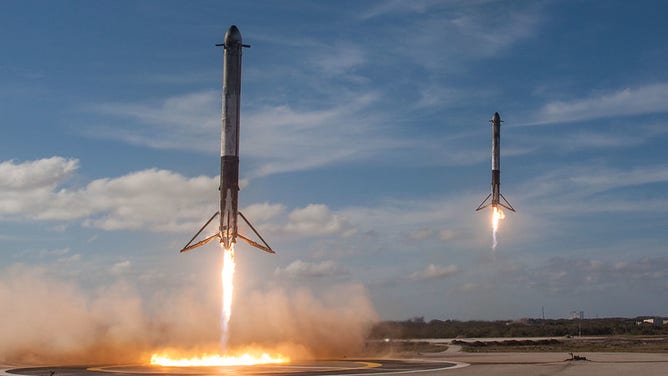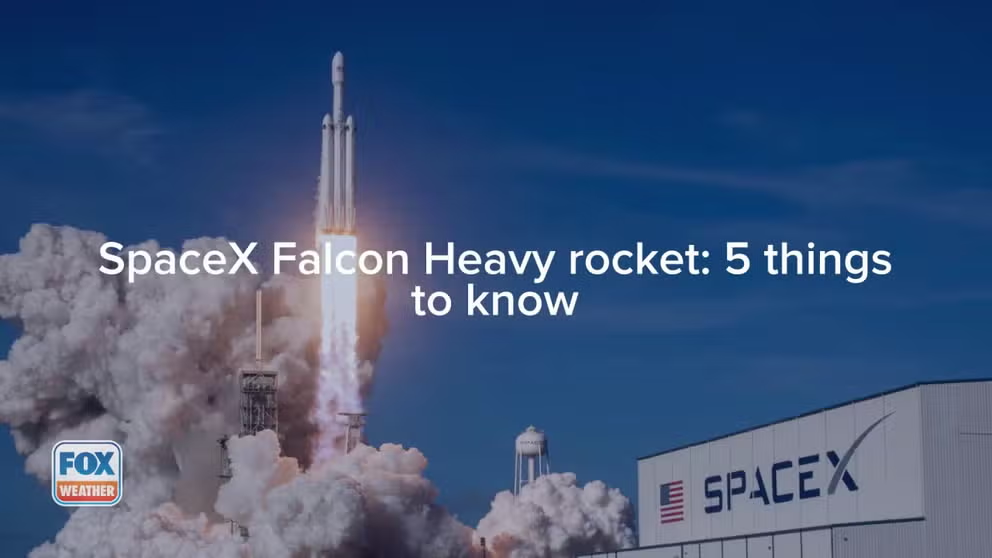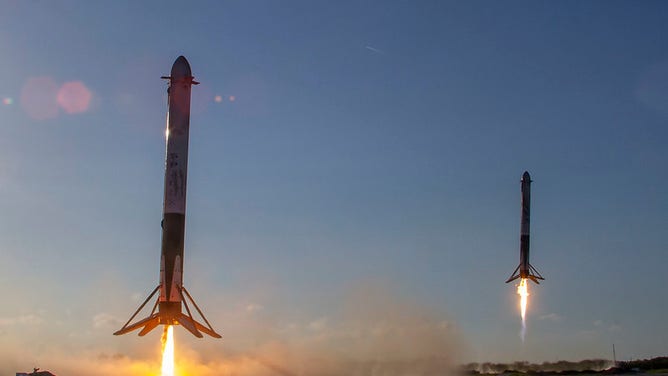Here come the booms: SpaceX targets Nov. 1 for first Falcon Heavy launch in 3 years
The Falcon Heavy boosters produce sonic booms that can be heard around Kennedy Space Center and as far inland as Orlando. SpaceX is targeting Nov. 1 to launch a U.S. Space Force payload on the Falcon Heavy.
5 things to know about the SpaceX Falcon Heavy rocket
As the world's most powerful rocket in operation, the SpaceX Falcon Heavy has 27 merlin engines and three rocket boosters.
KENNEDY SPACE CENTER, Fla. – After a three-year absence, SpaceX's powerful Falcon Heavy rocket has an upcoming launch from Kennedy Space Center.
SpaceX is targeting Nov. 1 at 9:41 a.m. to launch the Falcon Heavy with a U.S. Space Force mission. It will mark the first launch of the heavy lift vehicle and triple-booster landing since 2019. The private company, led by CEO Elon Musk, has been busy launching its workhorse rocket, the Falcon 9, on dozens of missions a year. But the Falcon Heavy is capable of launching much heavier payloads and is a unique experience to see in person.
After years of development, SpaceX conducted a demonstration mission on Feb. 6, 2018, of its new mega-rocket. Launching a new rocket is risky, and ahead of the liftoff, Musk gave the rocket a 50/50 chance of survival.
Still, with all 27 Merlin engines firing, producing more than 5 million pounds of thrust, the Falcon Heavy launched successfully. Unlike the Falcon 9, which has one first-stage booster, the 230-foot-tall Falcon Heavy rocket has three side-by-side boosters, each with nine engines creating an enormous roar for liftoff.
As the most powerful operational rocket in the world, the Falcon Heavy test flight makes it into FOX Weather's top five rocket launch moments of spaceflight history.
Triple booster landing

On Feb. 6, 2018, SpaceX launched the Falcon Heavy rocket on a test flight from Kennedy Space Center in Florida. After the launch, the three Falcon boosters came back for landing. One at sea just missed the mark but two boosters landed in uniform at Cape Canaveral Landing Zone 1. (Image: SpaceX)
SpaceX lands its rocket boosters on land and at sea to reuse the hardware, driving down the cost of launches by millions of dollars.
During the 2018 test flight, the three Falcon Heavy boosters performed a choreographed aerial ballet in the sky to return to Earth. The one booster missed its landing at sea on a droneship, but the two boosters headed for Cape Canaveral Landing Zone 1 stuck the touchdown in near-perfect unison.
As the boosters come back down, the rockets break the sound barrier, sending shock waves - or sonic booms - throughout the areas. The rumble can be heard from Kennedy Space Center as far inland as Orlando.
The double sonic booms set off many car alarms at KSC and rattled windows throughout Central Florida during the 2018 landing.
Being a test flight, no payloads were inside the Falcon Heavy rocket's nose cone, but Musk opted to send his cherry red Tesla Roadster into orbit instead. The electric car and its passenger "Starman," a mannequin dressed in a SpaceX spacesuit, continue to orbit the sun.

"Starman" in Elon Musk's Tesla roadster after launching in 2018 from Kennedy Space Center. (Image: SpaceX)
Since its maiden flight with Falcon Heavy, SpaceX has launched two payloads for different customers using the mega rocket.
In April 2019, the Falcon Heavy launched the Arabsat-6A satellite and the U.S. Department of Defense Space Test Program-2 mission for the U.S. Space Force in June of that year. STP-2 contained 24 satellites, including four NASA payloads.
Several more Falcon Heavy launches to come
After a years-long absence on the Eastern Range, the Space Coast will host several Falcon Heavy launches in the coming months and years.
After completing a static fire of the rocket boosters, SpaceX is targeting launching a classified mission for the U.S. Space Force on Nov. 1 at 9:41 a.m. ET. The USSF-44 spacecraft was initially scheduled to launch in 2020.
The Falcon Heavy will launch the USSF-44 payload from Kennedy Space Center launchpad 39A.
HOW SLS, NASA'S NEW MEGA MOON ROCKET, COMPARES TO APOLLO-ERA SATURN V
Residents around Central Florida should expect to get sonic boom warnings days before the launch.
The Falcon Heavy remains the most powerful rocket in the world until NASA's Space Launch System (SLS) takes flight later this year on the Artemis 1 test mission.
When the SLS launches, it will use solid rocket boosters and four RS-25 rocket engines to produce 8.8 million pounds of thrust to get off the Earth.
SpaceX has won other contracts for Falcon Heavy launches, including launching parts of Gateway, the orbiting moon outpost where astronauts will dock before heading down to the lunar surface.
Falcon Heavy will launch NASA's Power and Propulsion Element (PPE) and Habitation and Logistics Outpost (HALO), the foundation of Gateway.
Eventually, SpaceX plans to replace Falcon 9 and Falcon Heavy with its fully reusable Starship spaceship, which NASA has selected to land the first humans on the moon in over 50 years.








